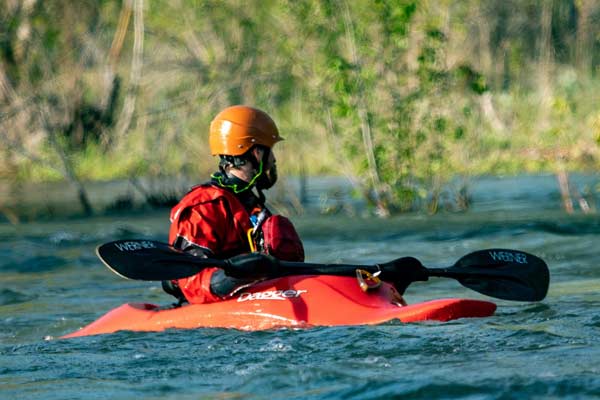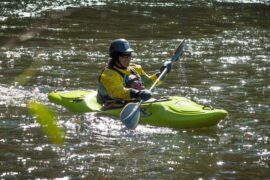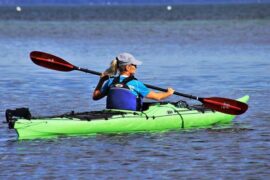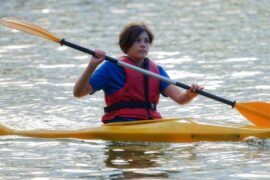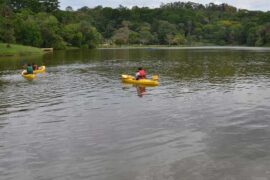If you love water sports, you probably have tried kayaking or scheduled it in your recreation program.
It is a lovely pastime because of the unique feeling you get maneuvering through the water, and you probably won’t get in other waterborne activities. However, you might experience the displeasure of getting wet.
There are things you can adjust if you want to kayak without getting wet. From your position in the kayak to the attire you wear, small changes can do the trick.
But why do kayaks get wet in the first place? Here is a simple explanation as well as an overview of tips to use to keep you dry.
Do You Always Get Wet When Kayaking?
Tiny droplets will fly up and hit you as you paddle. And even if you stay dry while kayaking, getting in and out of the kayak can be tricky and result in you getting wet. You might also get wet if you capsize, so learning how to the right your kayak is essential.
Why Do Kayaks Get Wet?
Your movement of the paddles and your own body almost guarantees the kayak gets wet. Because it is so low to the water, even small waves can splash water into the kayak.
Holes in the kayak can also cause water to enter and wet you. They could result from wear and tear or critters who have taken residence in your kayak. Water dripping down your paddles is another cause.
Do You Always Get Wet When Kayaking?
It is more a question of to what extent you get wet. Depending on the circumstances, it might be as little to negligible or a literal downpour on your cockpit. External factors such as the weather, the particular water body, and the type of kayak have a role to play.
Disadvantages of a Wet Kayak
A wet kayak is heavier and more challenging to paddle. There are a few disadvantages to having a wet kayak. First, it is uncomfortable and cold, which can ruin your time kayaking.
Also, if you are in salt water, it will corrode any metal parts on your kayak. Decreased maneuverability caused by the weight of the water is another disadvantage.
Tips for Getting in and Out of a Kayak Without Getting Wet
Entry and exit from the kayak are the first steps in preventing getting wet. Here are things to consider:
- Dry off completely before getting in your kayak
- The place you mount, getting into the kayak from a dock, is more accessible than getting in from the water.
- How do you position your kayak; if possible, keep it parallel to the shore or dock.
- The angle you get in and out; getting in and out at a 90-degree angle is best.
- The angle from which you approach the kayak; to get the best angle, you should be at a 45-degree angle to the kayak
- The side from which you enter; it is easier to get into the kayak from the side with the opening facing away from you
- How you sit in the kayak; when getting in, place your rear end first, then your legs, and finally your front
- How high do you step over the side of the kayak; the higher you step, the more likely you are to get wet
- Pushing off from the dock; rather than jumping into the kayak, gently lower yourself
- Exiting the kayak; when getting out, put your front end out first, then your legs, and finally your rear end
- Empty the water of your kayak after each use
Kayaking Without Getting Wet
Here is a checklist to use if you want maximum fun in your kayaking party but limit the getting wet (you probably do!)
- The attire is chosen; Wear the right clothes. You don’t want to wear cotton clothing because it will absorb water and get heavy. Instead, choose clothes made of quick-dry fabric or neoprene.
- Position in the kayak; sit as far back as possible in the cockpit to avoid getting splashed by water coming over the edge of the kayak.
- Paddle with hands close to the kayak; it will minimize the water that gets on your paddle and the kayak.
- Keep your feet up; if you keep them out of the water, you will be less likely to get them wet.
The equipment you use matters.
- Use a spray skirt; this is a piece of fabric that goes around the cockpit’s edge and helps keep water out.
- Choose a sit-on-top kayak; they are designed so you don’t have to sit in a pool of water inside the kayak.
- Type of paddle; choose one with a bent shaft to avoid water dripping down your paddle.
- You may also adjust your paddling technique. Here is how:
Stroking; when you paddle, ensure that your strokes are smooth and even. Avoid jerky or abrupt movements. - The angle of the paddle; when you are paddling, hold the paddle at a low angle to the water. It will help to keep water from splashing up onto the kayak.
- Body position; when you paddle, sit up straight and keep your body as close to the kayak’s center as possible. It will help you to maintain balance and control.
Finally, you must understand the conditions that affect any kayaking session. They include:
- The water body you choose to kayak in; to avoid getting wet, choose a calm water body with little or no waves.
- The weather; you have a lower chance of getting wet if it’s calm. However, there’ll be more water splash if it is gusty.
- Your kayaking skill level; compared to a seasoned kayaker, you have a higher chance of getting wet if you are a beginner.
- Your choice of kayak; a sit-on-top kayak will reduce your risk of getting wet compared to a standard kayak.
- State of the kayak; a well-maintained kayak is less likely to leak, reducing your chances of getting wet.
A backup and a standard helmet for white water kayaking are always advisable. Try them out next time you kayak and see whether there is a difference. With these tips, you can avoid getting wet while kayaking and have a great time.
